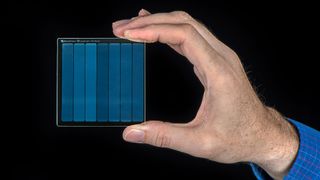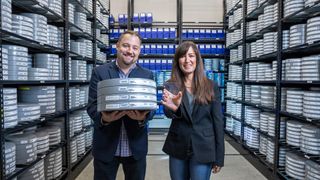Microsoft and Warner Bros. debut glass-based future of movie archiving
New storage medium could outlast human civilization itself

In a technological advancement normally reserved for science fiction, Microsoft has teamed up with Warner Bros. to successfully store and retrieve an entire copy of the 1976 classic Superman: The Movie on a coaster-sized piece of glass using the Redmond company's Project Silica storage solution.
Demonstrated as a proof of concept, Project Silica uses "ultrafast laser optics and artificial intelligence to store data in quartz glass," as explained at Microsoft's Ignite 2019 keynote.
- Best cloud storage 2019 for photos and pictures: free and paid
- Best cloud storage management services of 2019
According to the company's Innovation Stories blog, "A laser encodes data in glass by creating layers of three-dimensional nanoscale gratings and deformations at various depths and angles." A 2mm-thick piece of glass is able to hold around 100 layers of these gratings, also known as 'voxels' – the 3D equivalent of pixels.
Polarized light is then passed through the glass, which is decoded and read back using machine learning algorithms.
Super storage
Proving almost as indestructible as Superman himself, Microsoft's hard silica glass survived being boiled, scratched, scoured, demagnetized, microwaved, baked in an oven and more with not a single instance of data loss recorded.
In an effort to safeguard its huge library of historic films (both celluloid and digital), radio shows, TV shows, animated shorts, dailies and more, Warner Bros. approached Microsoft upon learning of its glass-based storage technology.
"For years, they had searched for a storage technology that could last hundreds of years, withstand floods or solar flares and that doesn’t require being kept at a certain temperature or need constant refreshing," said Jennifer Langston of Microsoft.
Get daily insight, inspiration and deals in your inbox
Get the hottest deals available in your inbox plus news, reviews, opinion, analysis and more from the TechRadar team.
Preservation

This is particularly important when it comes to the preservation of digitally-shot movies, which are typically archived by repeatedly copying and moving files across magnetic drives every few years.
Additionally, studios will also back up their movies by creating a third archival copy on analog film which is split into three color components and transferred onto black and white film negatives to avoid color fading – a process that's as expensive as it is convoluted.
“When we shoot something digitally — with zeros and ones representing the pixels on the screen — and print that to an analog medium called film, you destroy the original pixel values. And, sure, it looks pretty good, but it’s not reversible,” said Brad Collar, senior vice president of Warner Bros.
Of course, the Project Silica's glass-based storage is still in the proof of concept phase as of right now, however Microsoft Azure's chief technology officer Mark Russinovich is confident about the technology's future. “I’m not saying all of the questions have been fully answered, but it looks like we’re now in a phase where we’re working on refinement and experimentation, rather asking the question ‘can we do it?’”

Stephen primarily covers phones and entertainment for TechRadar's Australian team, and has written professionally across the categories of tech, film, television and gaming in both print and online for over a decade. He's obsessed with smartphones, televisions, consoles and gaming PCs, and has a deep-seated desire to consume all forms of media at the highest quality possible.
He's also likely to talk a person’s ear off at the mere mention of Android, cats, retro sneaker releases, travelling and physical media, such as vinyl and boutique Blu-ray releases. Right now, he's most excited about QD-OLED technology, The Batman and Hellblade 2: Senua's Saga.
